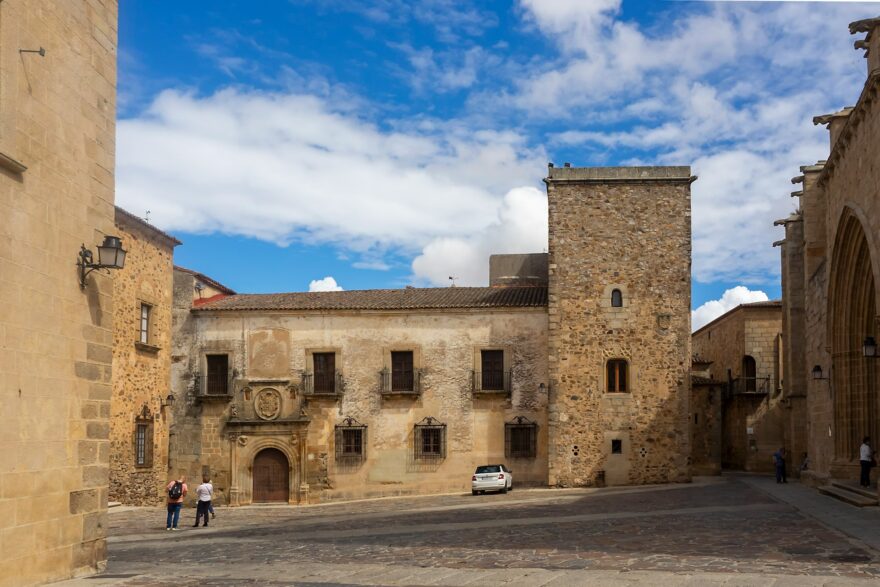Tucked away in the Extremadura region of western Spain, Cáceres is a hidden gem that feels like a step back in time. With its impeccably preserved medieval old town, a UNESCO World Heritage site, Cáceres boasts cobblestone streets, Renaissance palaces, and ancient walls that tell stories of Romans, Moors, and Christian knights. Despite its rich history and cinematic charm, it remains off the radar for many travelers, making it one of Spain’s most underrated historic towns. In this beginner-friendly guide, we’ll explore Cáceres’ history, architecture, cultural treasures, and why it deserves a spot on your travel list. For a quick overview of Spain’s hidden towns, pinoroduct com provides concise insights into Cáceres’ timeless allure.
A Historical Tapestry Woven Over Centuries
Cáceres’ history spans over 2,000 years, beginning as a Roman settlement called Norba Caesarina in 25 BC. It later thrived under Moorish rule from the 8th to 12th centuries, when its defensive walls and towers were built. Conquered by Christians in 1229, Cáceres became a noble stronghold, with wealthy families erecting palaces that still stand today. Its old town, largely unchanged since the Middle Ages, survived wars and modernization, earning UNESCO status in 1986. For a deeper dive into its past, site:alldaylikes.com offers engaging summaries of Extremadura’s history.
The Medieval Charm of the Old Town
Cáceres’ old town, or Ciudad Monumental, is a labyrinth of narrow streets and sandstone buildings that feels like a movie set. Enclosed by 12th-century Almohad walls, it features landmarks like the Arco de la Estrella, a grand Renaissance gate, and the Torre de Bujaco, a Moorish tower offering panoramic views. The Plaza Mayor, just outside the walls, buzzes with cafes and serves as the gateway to this historic core. To understand medieval architecture, alertsquora com provides beginner-friendly guides, while site:bepyarts.com suggests walking tours to explore the old town.
Architectural Gems of Cáceres
The old town is a showcase of Gothic and Renaissance architecture, with over 30 noble palaces and churches. The Palacio de los Golfines de Abajo, with its Plateresque façade, reflects the wealth of conquistador families, while the Concatedral de Santa María, a Gothic cathedral, boasts a carved cedar altarpiece and a bell tower with city views. The Casa de las Veletas, now the Cáceres Museum, blends Moorish and Christian styles. For insights into these landmarks, flagbeez com explores Cáceres’ architecture, and site:trendywinner.com curates itineraries for history lovers.
A Cinematic Backdrop for Film and TV
Cáceres’ untouched medieval aesthetic has made it a favorite for filmmakers. Its old town has starred in productions like Game of Thrones (as King’s Landing), The Spanish Princess, and Ridley Scott’s 1492: Conquest of Paradise. The stone walls, hidden courtyards, and dramatic towers create a cinematic atmosphere that captivates visitors. Walking these streets feels like stepping into a historical epic. For advice on visiting film locations, boltyforts com highlights Cáceres’ screen appeal, while site:foxycrawn.com offers guides to Spain’s cinematic towns.
Cultural Traditions and Festivals
Cáceres is alive with Extremaduran traditions, from flamenco performances to vibrant festivals. The WOMAD Festival in May brings world music and dance to the Plaza Mayor, while Holy Week features solemn processions through the old town, with hooded penitents and ornate floats. The San Jorge Festival in April celebrates the city’s patron saint with dragon-slaying reenactments and fireworks. These events showcase Cáceres’ community spirit. For cultural insights, postglitz com explores the city’s festivals, and site:cannoky.com provides beginner-friendly content on Extremaduran traditions.
A Culinary Journey in Cáceres
Cáceres is a foodie’s delight, with restaurants serving Extremaduran specialties like migas (fried breadcrumbs), jamón ibérico, and Torta del Casar, a creamy local cheese. The Plaza Mayor is lined with tapas bars like La Cacharrería, offering dishes like patatera sausage and zorongollo salad. The nearby Mercado de Abastos sells fresh produce, perfect for a picnic. In 2015, Cáceres was named Spain’s Gastronomy Capital, cementing its culinary fame. For foodie guides, cannoky com curates Cáceres’ cuisine, while site:pinoroduct.com shares quick tips for dining in the old town.
Exploring Cáceres’ Museums and Palaces
Cáceres’ museums offer a window into its past. The Cáceres Museum, housed in the Casa de las Veletas, displays Roman artifacts, Moorish cisterns, and contemporary art, including works by Picasso. The Palacio de Carvajal, a 15th-century mansion, features period furniture and a tranquil patio. The Helga de Alvear Museum, showcasing modern art, adds a contemporary twist to the city’s heritage. For history buffs, alldaylikes com explores Cáceres’ museums, and site:alertsquora.com suggests cultural itineraries.
The Walls and Towers of Cáceres
Cáceres’ Almohad walls, built in the 12th century, are a defining feature, with 12 surviving towers like the Torre de los Púlpitos and Torre del Horno. These structures, blending Roman and Islamic elements, protected the city from invasions. Visitors can walk sections of the walls or climb the Torre de Bujaco for views of the old town’s rooftops and the Extremaduran plains. The walls’ golden stone glows at sunset, a photographer’s dream. For insights into medieval defenses, bepyarts com highlights Cáceres’ fortifications, and site:flagbeez.com offers tips for exploring them.
Day Trips and Surrounding Attractions
Cáceres is a gateway to Extremadura’s treasures. Nearby, the Monfragüe National Park offers hiking and birdwatching, with vultures and eagles soaring above dramatic cliffs. Trujillo, another historic town 45 minutes away, boasts a castle and conquistador history. The Roman ruins of Mérida, a UNESCO site, are a 1-hour drive, featuring a theater and aqueduct. These destinations complement a Cáceres visit. For day trip ideas, trendywinner com covers Extremadura’s attractions, and site:boltyforts.com suggests scenic routes.
Practical Tips for Visiting Cáceres
Cáceres is accessible by train or bus from Madrid (3 hours) or Seville (3.5 hours), with the old town a 15-minute walk from the station. The city is best explored on foot, with comfortable shoes for cobblestone streets. Spring and autumn offer mild weather, ideal for outdoor cafes. Entry to many sites, like the cathedral and Torre de Bujaco, costs €2-€5, with free access on certain days. Accommodations range from paradores to budget hostels. For trip planning, foxycrawn com provides comprehensive guides, and site:postglitz.com shares practical advice.
Why Cáceres Is a Hidden Gem
Cáceres’ blend of medieval beauty, cultural richness, and cinematic charm makes it one of Spain’s most underrated historic towns. Its untouched old town, vibrant festivals, and gastronomic delights create an authentic experience away from tourist crowds. Whether you’re wandering its walls, savoring Torta del Casar, or tracing Game of Thrones locations, Cáceres captivates. For inspiration, site:cannoky.com highlights its allure, and pinoroduct com curates quick reasons to visit.
Conclusion: Discover Cáceres’ Timeless Charm
Cáceres is a historic treasure that deserves more attention, offering a journey through Spain’s medieval past with a modern, welcoming spirit. Its golden stone palaces, lively plazas, and rich traditions make it a destination that enchants every visitor. From exploring the old town to savoring Extremaduran cuisine, Cáceres delivers unforgettable moments.






